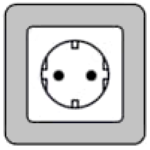Plug For Estonia: What You Need To Know
What is the plug for Estonia? Before you travel, check the information below to make sure your electronic devices are compatible with the outlet type and voltage.
Electrical Summary
Plug Compatibility: Type C, Type F
Voltage: 220V – 240V
Frequency: 50 Hz
Type C

Type F

Can North Americans use Electronics in Estonia without an Adapter?
No! North Americans will need an adapter for the outlets and a transformer for the voltage when traveling to Estonia. North Americans device plugs will not work with the outlet types in Estonia. Also, the voltage in Estonia is different from North American voltages.
Can Europeans use Electronics in Estonia without an adapter?
Yes! Europeans do not need a travel adapter or transformer when traveling to Estonia. Most device plugs will work with the outlet types in Estonia. Also, the voltage in Estonia is the same as in Europe.
What Outlet does Estonia Use?
Type C

Type C plug sockets are used in Europe, Africa and Asia. They have two round pins and no grounding pin. These plugs are typically used with devices that have a voltage of 220-240V. This outlet is rated for 2.5 amps. Plug Type E, and Type F are compatible with this socket. All other plug types will need an adapter.
Type F

Type F electrical plug sockets are used in Germany, Spain, Italy and some parts of Africa. They have two round pins and a grounding pin. These outlets are typically used with devices that have a voltage of 220-240V. This outlet is rated for 16 amps. Plug Type C and Type E are compatible with this socket. All other plug types will need an adapter.
Is it safe to drink water in Estonia?
The safety of drinking water in Estonia is generally good. According to the World Health Organization (WHO), nearly 100% of the population in Estonia has access to improved drinking water sources, which means that the water is from a protected well or spring, or treated through a piped system.
The water treatment system in Estonia is modern and meets European Union standards, and the tap water is safe to drink in most urban areas. However, in rural areas, the water quality may not be as good due to poor sanitation and lack of treatment facilities.
Even if the tap water is considered safe to drink in Estonia, it is still advisable to take precautions to avoid potential contamination. For example, it is recommended to boil tap water before drinking it or to use a water filter.
Alternatively, bottled water is widely available and is a safe option for drinking in Estonia. It is essential to ensure that the seal is intact before consuming the bottled water.
If you are traveling to Estonia, it is recommended to consult with a healthcare provider or a travel health specialist for specific recommendations on how to stay healthy and avoid waterborne diseases.
We recommend always packing a filtered water bottle when traveling:
Travel Essentials
Be sure to check our list of travel essentials before your trip!
Should I get travel insurance when traveling to Estonia?
It is generally recommended to get travel insurance when traveling to a different country. Travel insurance can provide financial protection and peace of mind in case of unexpected events, such as medical emergencies, trip cancellations, lost or stolen baggage, or other travel-related mishaps.
Travel insurance can cover various expenses related to your trip, such as medical expenses, emergency medical transportation, trip cancellation or interruption, lost or stolen baggage or personal belongings, and other travel-related expenses.
Before purchasing travel insurance, it’s important to carefully review the policy details, including the coverage limits, exclusions, and any applicable deductibles or copays. You should also make sure that the policy covers any activities or destinations that you plan to participate in or visit during your trip.
Travel Summary
Estonia is also known for its natural beauty, with over 50% of the country covered in forests, and nearly 2,000 islands scattered along its coastline. Visitors can explore Lahemaa National Park, Estonia’s largest national park, and home to pristine forests, waterfalls, and the stunning Viru bog. The country’s islands, such as Saaremaa and Hiiumaa, offer a unique blend of traditional village life, unspoiled nature, and cultural attractions.
Estonia is also a pioneer in digital technology, with a thriving start-up scene and a highly developed e-government system. Visitors can explore the country’s tech hubs, such as the Telliskivi Creative City in Tallinn, and attend events such as the annual Startup Day conference.
Estonian cuisine is a mix of Baltic, Russian, and Scandinavian influences, with local specialties such as black bread, smoked fish, and sauerkraut. The country is also known for its craft beer scene, with a range of small breweries offering unique flavors and styles.
Estonia is a welcoming destination for travelers, with a strong focus on sustainability and environmental protection. The official language is Estonian, but many people speak English as well. With its unique blend of history, nature, and innovation, Estonia is a must-visit destination for anyone looking to explore Northern Europe.
Traveling to another country? Check out our Countries page for more info.